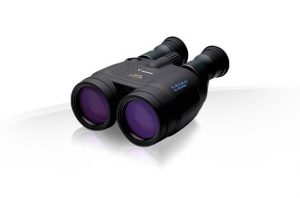 Canon broke the rules when it put IS technology into a 15x magnification bin.
Canon broke the rules when it put IS technology into a 15x magnification bin.
Their Canon 15x 50 IS binoculars arrived with excellent optics and an image stabilizer … and literally changed the picture for handheld magnification.
Canon has updated its lower-magnification bins in recent years, but expectant birders and stargazing fans have been disappointed in their wait for a refreshed 15x model.
The reason may be that the 15×50 is still one of Canon’s top-selling bins … let’s see what makes this classic bin so popular, and how it compares with its competitors today.
Introducing the Canon 15×50 IS All-Weather Binoculars
[wpsm_box type=”dashed_border” float=”none” text_align=”left” width=”100%” ]
[wpsm_column size=”one-half”]
[/wpsm_column]
[wpsm_column size=”one-half” position=”last”]
[wpsm_list type=”check” hover=”1″ gap=”medium”]
- Electronic Image Stabilization
- Ultra-Low Dispersion Lead-Free Glass
- Porro Prism Optical Path
- Fully Super Spectra Coatings
- Large Center Focusing Knob
- Fold-Down Rubber Eyecups
[wpsm_button color=”blue” size=”medium” link=”https://www.amazon.com/dp/B00006I53P/?tag=opticzoo-20″ icon=”none” class=”” border_radius=”0 px” target=”_blank” rel=”nofollow”]Check Price on Amazon![/wpsm_button]
[rehub_affbtn btn_text=”Check Price on B&H Photovideo!” btn_url=”https://bhpho.to/30siZrd” target=”_blank” ]
[/wpsm_column]
[/wpsm_box]
Canon’s 15×50 IS binoculars maintain a popular following because of their clarity and high-def views, durability, and – most of all – stunning stabilization.
They are made for birding and astronomy, and promise both image quality and viewing convenience.
The Canon 15×50 IS is one of only two All-Weather binoculars in the Canon line-up: the other is the Canon 18×50 IS. These two models are also the highest-powered bins the company produces.
The 15x Revolution
Magnification of 15x was never quite as popular as lower-powered 7xs, 8xs, and 10xs. Lower sizes naturally have a wider Field of View (FOV) and a brighter image — it’s just physics.
15x was often considered too shaky to handhold and too low-powered to bother mounting for stargazing. So … why?
Canon’s 15x bin is different: it has a stabilized image.
[wpsm_box type=”info” float=”none” text_align=”left”]
Though 15x bins usually can’t be handheld because of magnified shakiness, the 15×50 IS produces rock-steady views without a mount.
[/wpsm_box]
The revolution came in the form of being able to walk outside, lift up your bins, and start seeing…
Versatility
The 15×50’s image quality meets the high expectations of Canon’s optics. Low-dispersion glass is set in a Porro prism design using 50mm objectives that bring in good light.
Anti-reflective coatings aid light transmission, producing a bright image and better low-light performance.
[wpsm_box type=”info” float=”none” text_align=”left”]
Splash-resistance is another advantage of these unusual bins: unlike most IS models, they can actually stand up to field use.
[/wpsm_box]
Astronomers may not care so much, unless they enjoy looking at the Moon in the rain, but serious birders appreciate a bin that doesn’t get ruined by a morning dew — natural or commercial.
Though not without flaws, a synergistic combination of optics, IS and durability makes the 15×50 IS one of Canon’s most versatile bins. Skywatchers, hunters, and birdwatchers all have features to like in this ground-breaking favorite.
[wpsm_column size=”one-half”][wpsm_pros title=”PROS:”]
- 15x Magnification
- IS
- High Optical Quality
- All-Weather Construction
[/wpsm_pros][/wpsm_column][wpsm_column size=”one-half” position=”last”][wpsm_cons title=”CONS:”]
- Moderate weight
- Poor Close-Focus Range
[/wpsm_cons][/wpsm_column]
Features
High 15x Magnification
15x magnification takes you another step into the heavens if you’ve been using a normal low-powered field glass. 8x or 10x sizes don’t offer much satisfaction when looking at planets, much less star clusters.
[wpsm_box type=”info” float=”none” text_align=”left”]
The Canon 15×50 IS can reveal the bands on Jupiter and even rings around Saturn … while being handheld!
[/wpsm_box]
Image Stabilization (IS), or … “Wow that is so cool!”
15x magnification with IS produces images that are simply amazing, and provide fun viewing from a hammock or easy chair. These bins make it easy to become immersed in the scenery, which is a big part of why they are so popular.
The IS system isn’t made for heavy stabilization, such as when viewing from a moving vehicle or a wave-tossed boat. It handles normal handheld shaking very well, however, and responds quickly when activated.
Canon 15×50 Image Stabilized Binoculars Test:
Wide FOV
Higher magnification narrows a bin’s FOV, so it’s not a major ding against Canon’s 15×50 IS to admit it’s not huge. The 4.5º FOV is substantial for IS binoculars, however, and its 3.3mm exit pupil provides a well-lit, sharp image.
[wpsm_box type=”info” float=”none” text_align=”left”]
The lens use doublet field-flatteners to minimize chromatic aberration, a mild handicap of IS. The resulting image has consistency across the entire view, with only minor deterioration on the edges. You can sweep freehand and still capture wide-ranging detail.
[/wpsm_box]
Superior Optics
Canon uses a Porro prism with anti-reflective Super Spectra Coating in a tightly-calibrated design. Light from the generous 50mm objectives delivers a bright image that earns high praise from stargazers.
The IS mechanism uses Ultra-Low Dispersion glass in a Vari-Angle Prism configuration that maintains color faithfulness even after IS “correction.”
Convenient Handling
The premium cost of a Canon includes the promise of convenience. Here’s a rundown of potential hotspots:
- Ergonomics – These bins don’t feel as mass-produced as they actually are. Canon’s ergonomics are generally consistent; if you like the feel of one of their bins, you’ll generally like these too. (Pro Tip: Try them first!)
- Grip – The sleek housing is covered in rubber armor that grips easily and helps protect the optical elements.
- Focus Adjustment – The large focus knob is mounted on the center of the bins for convenient access. It turns smoothly and holds settings well.
- IS Button – Stabilization is activated with a button on the right side. It’s conveniently placed for your finger to hold down, and there’s a 5-minute hold setting for longer sessions.
- Weight – Fans (and marketing literature) describe the 15×50’s as “light” bins, but that’s just a relative notion, since most higher-mag IS bins lean less toward a paperweight and more to a boat anchor. They weigh 41.6 oz, or over 2 1/2 lbs.
- Eye Relief – The eyecups fold down for more room, and the 15 mm eye relief is long enough for most users to wear eyeglasses.
- Eyecups – Canon miffed here. The bad news is that the eyecups are stiff, oversized, and bulky. Sadly, if they don’t fit well, there really isn’t any good news: they can let in stray light and their rigidity makes them uncomfortable to press down on. The eyecups are an important element to enjoying these bins, so it’s important to try them out before buying.
- Battery Power – Optics companies have been bravely willing to put flaky battery-powered electronics into their expensive, high-end systems … but Canon shows restraint. You can use common AA or lithium batteries, and plan on 2-8 hours use out of a battery, depending upon the type and how much you’re using the IS.
- Packaging – Canon doesn’t add much in the way of extras to the 15×50. In fact, the company’s response to customer complaints about the flimsy objective lens was to leave them off entirely. No Soup for YOU.
Review comparison of Canon 12×36 IS II and/vs 15×50 IS AW:
All-Weather Construction
It surprises sensible people to realize IS manufacturers often leave their prized electronic and optical equipment open to the elements.
Most mega-corporate brands produce high-end (expensive) equipment that is basically disposable and intended to fail (and be replaced) within 5 years. Just a consumer update.
That’s why the Canon 15×50 IS All-Weather construction is so valued. The bins are protected to meet JIS standards for Grade Four water-resistance.
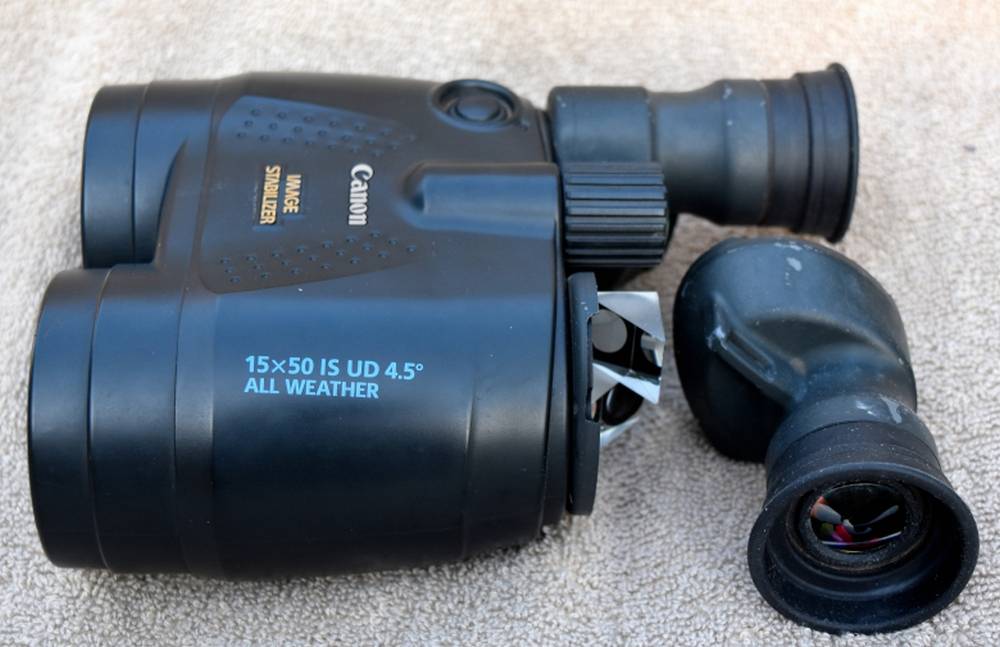
Let’s not go overboard though. This only means it can withstand splashing water: it’s far from submersible. A directed stream can kill them.
The bins will likely survive a light rain or a heavy dew, which is great news for those who like to view birds outside.
Alternatives
[wpsm_box type=”dashed_border” float=”none” text_align=”left” width=”100%” ]
1. Canon 18×50 IS Review
[wpsm_column size=”one-half”]
[/wpsm_column]
[wpsm_column size=”one-half” position=”last”]
[wpsm_list type=”check” hover=”1″ gap=”medium”]
- Porro Prism
- Image Stabilizer Technology
- Field-Flattening Lenses
- UD Ultra-Low Dispersion Element
- Accepts 58mm Filters & Lens Hoods
- Weatherproof Housing
[wpsm_button color=”blue” size=”medium” link=”https://www.amazon.com/dp/B00004THDE/?tag=opticzoo-20″ icon=”none” class=”” border_radius=”0 px” target=”_blank” rel=”nofollow”]Check Price on Amazon![/wpsm_button]
[rehub_affbtn btn_text=”Check Price on B&H Photovideo!” btn_url=”https://bhpho.to/30nOVNf” target=”_blank” ]
[/wpsm_column]
[/wpsm_box]
If you’re interested in the minimalist approach to stargazing and birding that Canon offers, you might take a look at the other All-Weather bin in their line-up: the Canon 18×50 IS.
It’s another popular old-timer with a stargazer’s focus, and it has a unique combination of features that hasn’t quite been matched.
Aside from the magnification boost, the chassis and optical performance are basically identical to the Canon 15×50 IS.
The optics are still good, though a little stressed by the higher magnification — the FOV is inevitably narrower, the image has less light, the IS is a tiny bit shakier.
It’s still an incredibly detailed, gorgeous view … and it steps over the 15x versatile-use threshold into a real astronomy glass.
[wpsm_column size=”one-half”][wpsm_pros title=”PROS:”]
- High 18x magnification
- IS almost equal to the 15×50
- Excellent Canon optics
[/wpsm_pros][/wpsm_column][wpsm_column size=”one-half” position=”last”][wpsm_cons title=”CONS:”]
- Smaller FOV
- Less bright than 15×50
[/wpsm_cons][/wpsm_column]
Check out the Canon 18×50 IS online!
[wpsm_box type=”dashed_border” float=”none” text_align=”left” width=”100%” ]
2. Canon 14×32 IS Review
[wpsm_column size=”one-half”]
[/wpsm_column]
[wpsm_column size=”one-half” position=”last”]
[wpsm_list type=”check” hover=”1″ gap=”medium”]
- Lens-Shift Image Stabilization
- Field-Flattener Lens System
- Super Spectra Multi-Coated Optics
- Normal and Powered IS Modes
- Simple 2-Button User Interface
- Fold-Down Rubber Eyecups
[wpsm_button color=”blue” size=”medium” link=”https://www.amazon.com/dp/B0744MJ943/?tag=opticzoo-20″ icon=”none” class=”” border_radius=”0 px” target=”_blank” rel=”nofollow”]Check Price on Amazon![/wpsm_button]
[rehub_affbtn btn_text=”Check Price on B&H Photovideo!” btn_url=”https://bhpho.to/30sFSe1″ target=”_blank” ]
[/wpsm_column]
[/wpsm_box]
The latest Canon binoculars have a new “Shift” IS system that produces the same optical performance with smaller objective lenses.
A new power, 14x, was added as one of these bins in 2017.
Though these Shift binoculars were kind of yawn-producing compared with expectations, the technology may bode well for higher magnifications and upgrades down the road.
The Canon 14×32 IS produces a sharp, high-contrast image with even less chromatic aberration on the edges, and has an outstanding close-focus range of just 6.6 feet.
These are much lighter than the Canon 15×50 IS, at only 27.3 vs 41.6 ounces — almost a pound less. Ouch.
The FOV and most optical specs are a bit less, though, and Canon’s own description of this model’s weatherproofing is literally “-“. They are also quite pricey, but … did I mention they were new?
[wpsm_column size=”one-half”][wpsm_pros title=”PROS:”]
- New Canon model
- New Shift-method IS
- High optical quality equal to the 15×50
- Lightweight
- Impressive Close-focus Range up to 6.6′
[/wpsm_pros][/wpsm_column][wpsm_column size=”one-half” position=”last”][wpsm_cons title=”CONS:”]
- Expense
- Smaller FOV
- Image slightly less bright
- No Weatherproofing
[/wpsm_cons][/wpsm_column]
See the Canon 14×32 IS online!
[wpsm_box type=”dashed_border” float=”none” text_align=”left” width=”100%” ]
3. Fuji TECHNO-STABI 14×40 Review
[wpsm_column size=”one-half”]
[/wpsm_column]
[wpsm_column size=”one-half” position=”last”]
[wpsm_list type=”check” hover=”1″ gap=”medium”]
- ±5° Stabilization
- Phase-Coated BAK4 Roof Prisms
- Full Fujinon EBC Multi-Coatings
- Optional Eyepiece Filters
- Fold-Down Eyecups
- Waterproof & Fogproof
[wpsm_button color=”blue” size=”medium” link=”https://www.amazon.com/dp/B0000C16R8/?tag=opticzoo-20″ icon=”none” class=”” border_radius=”0 px” target=”_blank” rel=”nofollow”]Check Price on Amazon![/wpsm_button]
[rehub_affbtn btn_text=”Check Price on B&H Photovideo!” btn_url=”https://bhpho.to/30nMpGN” target=”_blank” ]
[/wpsm_column]
[/wpsm_box]
The Fuji TECHNO-STABI 14×40 has both water- and fog-proof seals, making them rugged for outdoor use. Many prefer the ergonomics, too. They don’t have the optical quality of Canon’s, though.
The IS system is designed for more rigorous shaking and swaying, so it’s become the must-have boating glass in recent years.
It isn’t a twilight or an astronomer’s bin, and at 2.71 lbs they are heavier than the Canon 15×50 IS … but a lot of people like them.
[wpsm_column size=”one-half”][wpsm_pros title=”PROS:”]
- IS system with high correction
- Water- and fog-proof construction
- Clear image
[/wpsm_pros][/wpsm_column][wpsm_column size=”one-half” position=”last”][wpsm_cons title=”CONS:”]
- Optical quality generally lower than Canon
- Heavier than the 15×50
[/wpsm_cons][/wpsm_column]
Check out Fuji TECHNO-STABI 14×40 online!
Conclusion
The company is known for quality consumer optics that are easy to operate — even if they aren’t so easy on the wallet.
Their emphasis on convenience and optical quality has made them a market leader, and some of their older bins like the 15×50 are still among the most popular IS bins.
Lot of fans swear by these classic bins. Their optics and IS produce amazing images with great contrast for celestial or terrestrial viewing. The All-Weather feature makes them versatile too.
They are pricey, though. You shouldn’t count on passing them on to your children, either. Expect three to five years, and accept that repairing them is too costly once the warranty period is over.
If you’re looking for a premium experience, though, Canon represents the best optical quality in IS binoculars available before the price takes off for the stratosphere.
If your budget allows, the Canon 15×50 IS are excellent versatile bins with an edge: “Wow! That loks so cool!”
Check out the Canon 15×50 IS online …
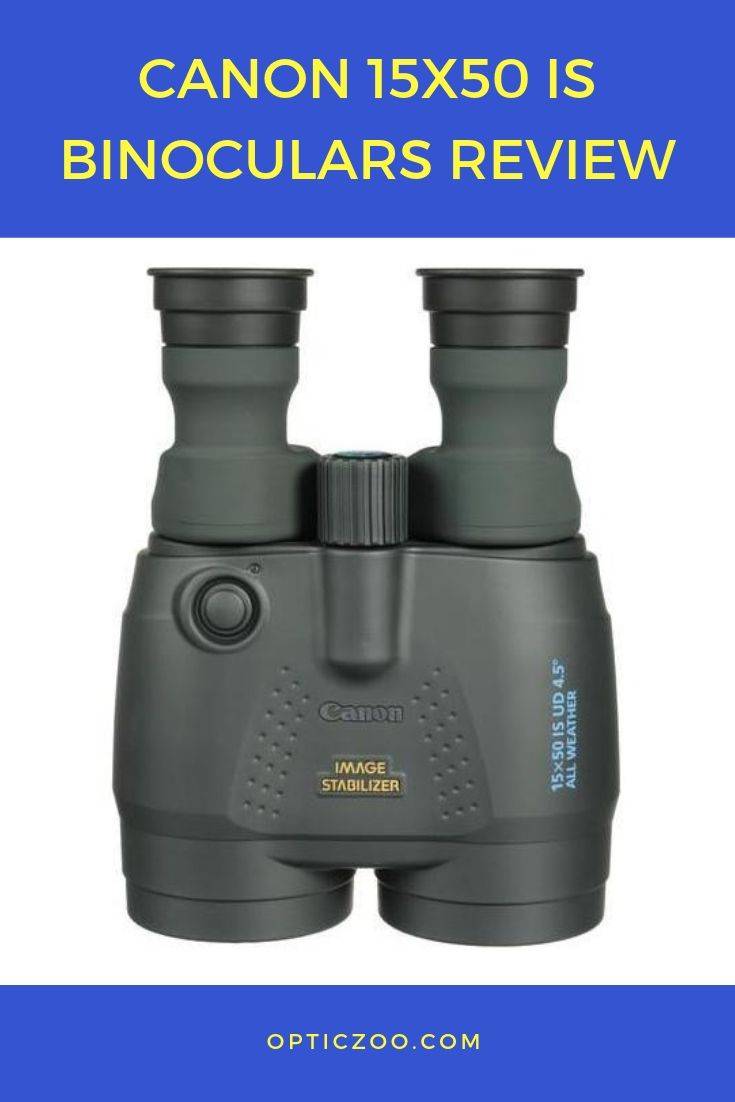

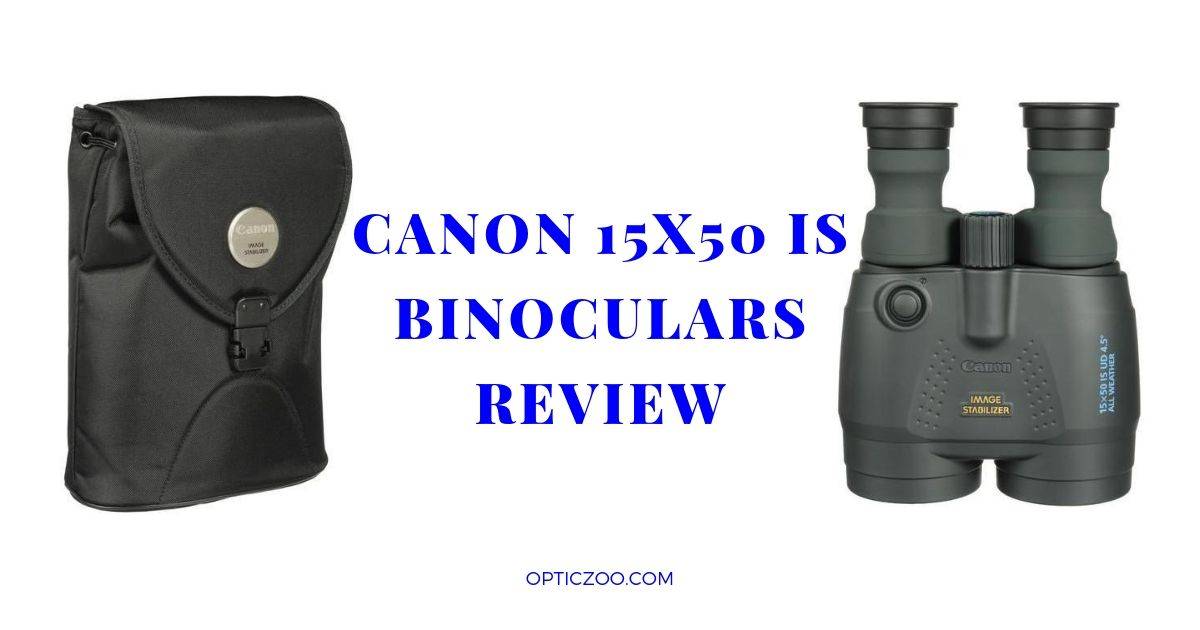
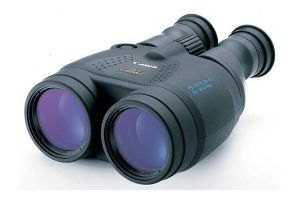
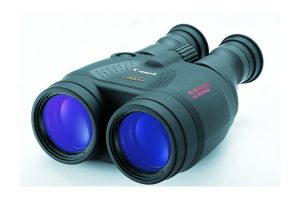
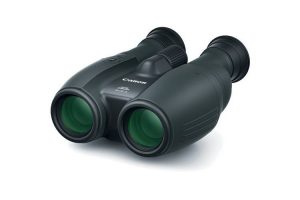
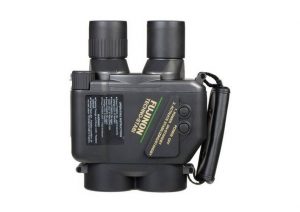
which IS of 15 x 50 and 18 x 50 is more clearer of objects in 1/2 mile.
Are the 15×50 better optically than the 14×32 … what I am getting at it the sharpness and contrast. I get one is 50 and the other 32 … but am interested in if the newer model is just not as sharp ?
very thorough reviews! I opted for the Canon 15×50 for use primarily in Astronomy but they are just such a joy I can see myself lugging them out on walks to do some bird spotting and just generally admiring the surroundings they are such an amazing instrument. I have seen saturns rings and 4 moons of Jupiter (no bands on jupiter as yet) They show off the colours of stars beautifully and bring huge swathes of stars into view, the moon is captivatind, they frame the pleiades perfectly, M31 and M13 easily found. A joy to use. The main reason I am posting is to reccommend some objective lens covers, You will find many dealers on ebay uk or us selling pop up riflescope objective covers. Order a pair of the 69mm diameter. they do a beautiful job. Those Canon snap on lens caps can go in the trash. Cheers
Dave